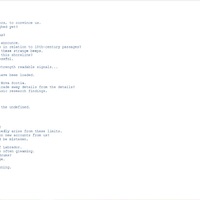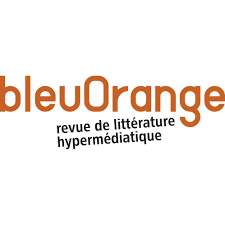-
Titre
-
TRANS.MISSION [A.DIALOGUE]
-
Créateur
-
J.R. Carpenter
-
Contributeur
-
Ariane Savoie (traduction)
-
Netwurker Me (traduction en mezanglle)
-
Date de création
-
2011
-
Langue
-
Français
-
Anglais
-
mezanglle
-
Résumé
-
TRANS.MISSION est un dialogue généré par ordinateur. À chaque fois que la page web est chargée (soit en accédant au site internet ou en rafraîchissant la page), un nouveau dialogue est généré. Il commence toujours de la même façon, soit avec :
« Begin transmission.
How? ou Why? »
Le dialogue continue ainsi avec un « interlocuteur » qui pose des questions et un autre qui répond. Certaines lignes rappellent l'interférence qu'il peut y avoir dans les relations dialogiques à longue distance (ex : « Receiving flickering disturbances, a few scraps of a private message... », « A pattern, no signals received, probably not sending... »)
-
Description
-
TRANS. A prefix meaning: across, beyond, through. A prefix used in combination with an element of origin: transatlantic. A prefix implying a state of change: transmit, transfer, transfix, transport. A prefix implying poetry: transverse. From the Latin versus: literally, a turning, to turn. Every verse has a re-verse. In Greek verse, Strophe sets out from east to west across the stage. Antistrophe replies from west to east. Neither voice is in either place. Both are calling: across, beyond, through.
MISSION. A group or committee of persons sent to a foreign country to provide assistance, conduct negotiations, establish relations, initiate communications, build fortifications or in any other way forge something familiar somewhere strange. The business with which such a group is charged. An operational task, designed to carry out the goals of a specific program. A computer program, for instance. function produce_stories() From the Latin missio: a sending off, to send. On a mission.
DIALOGUE. A conversation between two or more persons. A literary work in the form of a conversation: a dialogue of Plato. From the Greek dialogos: dia-, meaning: across + logos, meaning: a word, saying, speech, discourse, thought, proportion, ratio, or reckoning. Akin to légein: to choose, gather, recount, tell over, or speak.
TRANS.MISSION [A.DIALOGUE] is a computer-generated dialogue, a literary narrative in the form of a conversation, a discourse propagating across, beyond and through long-distance communications networks created and necessitated by generations of transatlantic migration. One JavaScript file sits in one directory on one server attached to a vast network of hubs, routers, switches, and submarine cables through which this one file may be accessed many times from many places by many devices. Each time this JavaScript is called, the network, the browser, and the client-side CPU conspire to respond with a new iteration. The mission of the JavaScript source code is to generate another sort of script, a dialogue to be read aloud in three voices: Call, Response, and Interference; or: Strophe, Antistrophe, and Chorus; or Here, There, and Somewhere in Between. This multi-site-specific dialogue resonates in the spaces between places separated by time, distance, and ocean, yet inextricably linked by generations of immigration.
[A.DIALOGUE] begins like any other transmission. With a call: Begin! Followed by a response: How? With a question. What we write is always a question. A question desires a reply. What emerges from a question? Distant shores, to lure us. One coastline implies another, implores a far shore. This entreaty, this call intrigues me. In Writing and Difference, Derrida observes, "Site, this land, calling to us from beyond memory, is always elsewhere. The site is not the empirical and national Here of a territory. It is immemorial, and thus also a future." In her long poem, The Fall of Rome: A Traveller's Guide, Canadian poet and classicist Anne Carson writes: "A journey …/ begins with a voice / calling you name out / behind you. / This seems a convenient arrangement. / How else would you know it's time to go?"
And so Strophe sets out from east to west on a treacherous mission, across high seas and frozen wastes, in search of a Northwest passage, in hopes of trade routes, and fountains of eternal youth. And Antistrophe returns from west to east with scurvy, captive natives, and furs. Neither ever arrives. Both only just barely finish leaving. Likewise a reader can never quite reach the end of this TRANS.MISSION. Mid-way through a new version is generated. The sentence structures stay the same, but all their variables change. Relations shift as time passes, so that we have immigrants now, where once we had explorers; a persistent tap eclipses a strange whir; a message instead of a passage; Nova Scotia in place of Scotland; a submarine cable replaces a shipping network. How different is the narrative of one journey from the next?
TRANS.MISSION [A.DIALOGUE] is a mechanical construction, a sentence engine performing the programmatic function of associating suspended variables with syntactic signification that they might travel through networks and emerge intact as narrative units. The dialogue generated by this engine is both technically and topically inflected with the syntax and grammar of code language. Technically, the source code of TRANS.MISSION [A.DIALOGUE] was not entirely crafted by me. Less a craft than a crude life raft, my code is adapted from a JavaScript version of a Python narrative generator called The Two, created by Nick Montfort in 2008. Though the nature and form of Montfort’s narrative were substantially transformed in the creation of the Python version of TRANS.MISSION [A.DIALOGUE], and then further in the translation of the transmutation into JavaScript, something of the uncanny twinning of characters at work in The Two underpinned underpinned my process production; my hack transforms Montfort’s source code into a code medium, sending and receiving dialogue on and through media haunted by generations of past usage.
Topically, TRANS externalises a poetics of technology. Codes, their creators, the modes through which they operate, propagate, and communicate, and the confusion they instigate are the main topic of the dialogue TRANS.MISSION generates. TRANS.MISSION [A.DIALOGUE] generates cacophony, liminality, atemporality and asynchronous exchanges of mixed messages pertaining to miscommunications and network failures. Strophe and Antistrophe call and respond between here and there with Chorus running interference in between, confusing and confounding boundaries between physical and digital, code and narrative, past and future, home and away.
Mention de genre autodéclarée : « computer-generated dialogue, a literary narrative in the form of a conversation, a discourse propagating across, beyond and through long-distance communications networks »
-
Thèmes
-
Communication
-
Dialogue
-
Distance
-
Ère technologique
-
Interférence
-
Océan
-
Extraits de l'œuvre
-
« What starts from a formal investigation? / Autumn shadows on the surf. Distant coasts, to entreat us. / Haven't the crucial packages been measured yet? / The manager signals her instructions. »
-
Réception et sources
-
Leonardo Flores pour I Love E-Poetry, « “TRANS.MISSION A Dialogue” by J.R. Carpenter », publié le 20 mai 2012.
-
J.R. Carpenter, « Translation, transmutation, transmediation, and transmission in TRANS.MISSION A.DIALOGUE », présenté à “Translating E-Literature” Paris 8, Paris, France du 11 au 14 juin 2012 et publié dans le E-Journal du NT2.
-
Barbara Bridger, « Dramaturgy and the Digital » pour Exeunt Magazine
-
Étudié dans la thèse de doctorat de J.R. Carpenter, « Writing Coastlines: locating narrative resonance in transatlantic communication network », publiée en 2015.
-
Présenté dans le cadre de « Perdu » du ELMCIPresearch – Electronic literature as a model of Creativity and Innovation in Practice, le 10 décembre 2011.
-
Laboratoire NT2
-
ELMCIP
-
Mentionné dans l'entrée du 24 juin 2012 du blogue de l'autrice sur Goodreads.
-
Personne ayant créé la fiche
-
Aude Meunier-Rochon
 trans.mission - 1.jpg
trans.mission - 1.jpg

